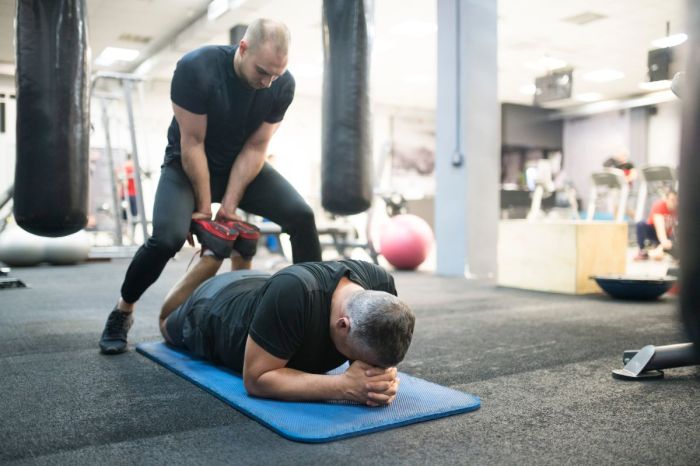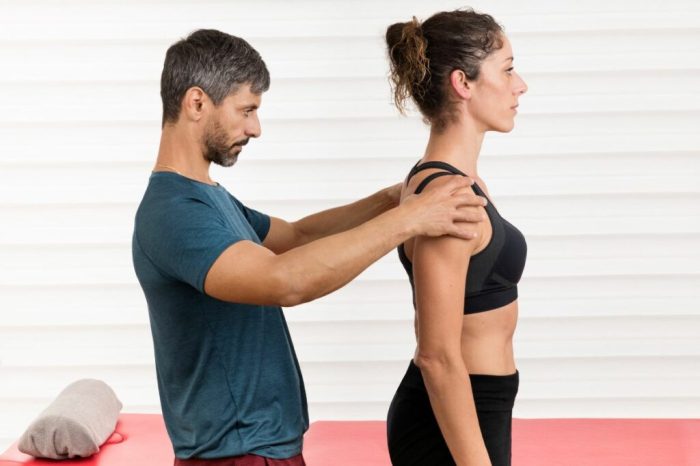What distinguishes active isolated stretching from other stretching exercises – Active isolated stretching (AIS) stands out among stretching techniques due to its unique approach and effectiveness. This article delves into the key distinctions of AIS, comparing it to other common stretching methods and exploring its applications, benefits, and limitations.
AIS involves isolating specific muscle groups, actively contracting them, and then gently stretching them. Unlike passive stretching, AIS engages the muscles, promoting flexibility and range of motion while minimizing the risk of injury.
Overview of Active Isolated Stretching
Active Isolated Stretching (AIS) is a unique form of stretching that combines active contraction with isolated muscle targeting. Unlike passive stretching, AIS involves actively contracting specific muscles while simultaneously stretching them. This approach is based on the principles of neurology and physiology, utilizing the body’s natural reflexes to enhance flexibility and range of motion.
Principles and Mechanics of AIS
AIS involves three primary steps:
- Isolating the target muscle group by positioning the body in a way that minimizes compensation from other muscles.
- Actively contracting the isolated muscle group against resistance, typically provided by the body itself or an external object.
- Stretching the contracted muscle group to its end range of motion while maintaining the contraction.
Benefits of AIS
- Improved flexibility and range of motion
- Reduced muscle tension and soreness
- Enhanced joint mobility
- Improved posture and body alignment
- Reduced risk of injuries
Comparison to Other Stretching Techniques
Common Stretching Exercises
Other common stretching techniques include:
- Static stretching: Holding a stretch for an extended period without movement.
- Dynamic stretching: Involving movement and momentum to prepare muscles for activity.
- Proprioceptive neuromuscular facilitation (PNF): Using specific techniques to facilitate muscle relaxation and contraction.
AIS vs. Other Techniques
AIS differs from these techniques in several ways:
- Isolation of specific muscles: AIS focuses on isolating individual muscle groups, while other techniques may involve stretching multiple muscles simultaneously.
- Active contraction: AIS involves active muscle contraction, while other techniques may use passive stretching or rely solely on external forces.
- Emphasis on end range of motion: AIS stretches muscles to their full range of motion while maintaining active contraction, which is unique compared to other methods.
Effectiveness of AIS
Research has shown that AIS is effective in improving flexibility and range of motion, reducing muscle tension, and enhancing joint mobility. Studies have also indicated that AIS may be more effective than other stretching techniques in certain situations, such as rehabilitation after injuries.
Key Distinctions of AIS

Isolating Specific Muscles
AIS emphasizes isolating specific muscles by using body positioning and targeted movements. This approach ensures that the target muscle group is stretched without compensation from other muscles, leading to more effective and efficient stretching.
Active Contraction
Active contraction is a key component of AIS. By actively contracting the target muscle group against resistance, the stretch reflex is inhibited, allowing the muscle to relax and stretch more deeply.
Difference from Passive Stretching
AIS differs from passive stretching, which involves relaxing the target muscle group and relying on external forces to stretch it. AIS, on the other hand, utilizes active contraction to facilitate stretching, making it a more dynamic and targeted approach.
Applications and Usage

Beneficial Conditions
AIS is beneficial for a variety of conditions, including:
- Muscle tightness and stiffness
- Reduced range of motion
- Muscle imbalances
- Post-injury rehabilitation
- Improving athletic performance
Incorporation into Programs
AIS can be incorporated into rehabilitation and fitness programs in various ways:
- As a standalone stretching routine
- As part of a warm-up or cool-down
- To address specific muscle imbalances or injuries
- To enhance flexibility and range of motion for specific activities
Importance of Proper Form
Proper form and technique are crucial in AIS. It is important to isolate the target muscle group, contract it effectively, and stretch it to its end range of motion while maintaining the contraction.
Benefits of AIS over Other Techniques: What Distinguishes Active Isolated Stretching From Other Stretching Exercises

Evidence-Based Advantages, What distinguishes active isolated stretching from other stretching exercises
Research has consistently demonstrated the benefits of AIS over other stretching techniques. Studies have shown that AIS is more effective in improving flexibility, reducing muscle tension, and enhancing joint mobility.
Potential Long-Term Effects
Regular AIS practice can lead to lasting improvements in flexibility and range of motion. By consistently isolating and stretching specific muscle groups, AIS helps maintain optimal muscle function and prevent stiffness and tightness.
Improvement of Flexibility and Range of Motion
AIS specifically targets the stretch reflex, which inhibits muscle contraction and allows for deeper stretching. This unique approach makes AIS highly effective in improving flexibility and range of motion, enabling individuals to move more freely and efficiently.
Cautions and Limitations

Potential Risks and Contraindications
While AIS is generally safe, it is important to be aware of potential risks and contraindications:
- Overstretching: Pushing a stretch too far can lead to muscle damage or injury.
- Muscle strain: AIS involves active contraction, which can strain muscles if not performed properly.
- Certain medical conditions: AIS may not be suitable for individuals with certain medical conditions, such as joint instability or osteoporosis.
Importance of Listening to the Body
It is crucial to listen to your body and avoid overstretching. Pain is a signal that the body is being pushed too far, and it is important to respect these limits.
Proper Guidance and Supervision
It is recommended to seek guidance from a qualified healthcare professional or fitness expert before performing AIS, especially if you have any underlying health conditions or injuries.
Essential FAQs
What is the primary difference between AIS and other stretching techniques?
AIS involves isolating specific muscles, actively contracting them, and then gently stretching them, while other techniques typically focus on passive stretching.
What are the benefits of AIS over other stretching methods?
AIS has been shown to improve flexibility, reduce the risk of injury, and potentially have long-term effects on range of motion.
Is AIS suitable for all individuals?
While AIS is generally safe and effective, it is important to consult with a healthcare professional before beginning any new stretching program, especially if you have any underlying health conditions.